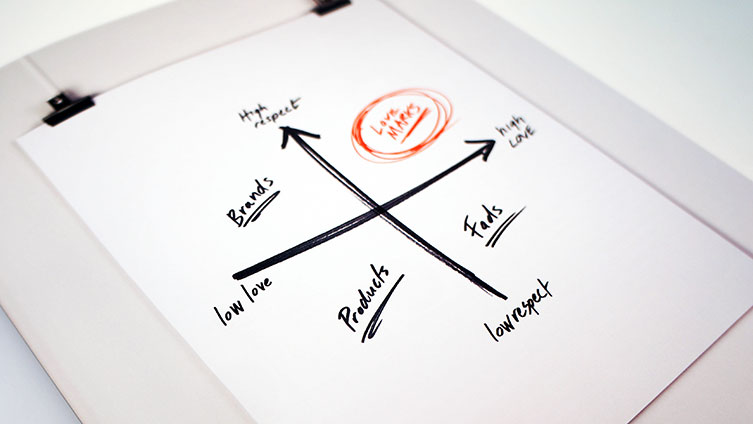Love On the Edge
Tuesday, 2 February 2010 - Wellington, New Zealand

Presentation Summary
Speaking to leading winemakers and connoisseurs at Pinot Noir 2010, Kevin Roberts shares his ideas to help New Zealand Pinot Noir thrive in a competitive world market. To create and sustain premium margins, Kevin highlights the importance of making Lovemarks, investing in global marketing from the edge, thinking from the “shelf back” to reach the heart of the consumer, and building participation.
I came to New Zealand in 1989 to run Lion Nathan – where we already owned NZ W&S and were looking hard at expanding into wine.
I also owned GAULTS on Quay – with Chef Simon Gault where we spotlighted New Zealand wines.
The last decade has seen an explosion of creativity in New Zealand, in film, music, dance, food, and wine. Everywhere except in a rugby world cup final. Which will all change next year!!!
There’s a lot to celebrate in the art of making Pinot Noir in New Zealand – but not a lot of time to spend doing it, because the three most dangerous words in the business vocabulary are “we’ve made it”.
Edward de Bono says “there’s no point in being brilliant at the wrong thing”. One New Zealand winegrower was interviewed about the strategy of pushing bulk wine into the export market. He described this as “looting brand New Zealand”. He’s spot on.
If you believe that the reputation of New Zealand wine is so robust that it can withstand bad tactical decisions and creeping commoditisation, be scared, very scared. The industry’s reputation is no less fragile than the pinot noir grape itself.
Warren Buffett summed it up with typical directness: “It takes 20 years to build a reputation and five minutes to ruin it.”
The very fine Australian wine industry is in danger of turning into a reverse case study – of what not to happen.
Across the Tasman, there are reports that they can make wine so cheap it can sell for less than bottled water and even Coca-Cola. Granted, it might not be very good – but as they used to say in that UK TV show of the 60s: Never Mind the Quality, Feel the Width!!!!
The Wine Australia website describes wine as a “fast moving consumer good”. Let that sink in: “a fast moving consumer good”. Like milk powder or hair gel. Or laundry detergent.
How then does New Zealand Pinot Noir – and New Zealand wineper se – continue to attract premium margins in a hyper-competitive world?
I have four ideas for creating premium margins.
1. MAKE LOVEMARKS
Ten years ago I observed that brands were suffocating under the weight of their own volume. Everything was a brand. Parity was rampant. How to break out of the pack?
Recognize reason leads to conclusions, emotion leads to action…then shoot for love, the deepest of all emotions. Ask 100 CEOs if they want their brands to be liked, or loved, and you get a unanimous response.
Brands are dead. Welcome to the future…Welcome to Lovemarks.
Brands are owned by management, marketers and stockholders. Lovemarks are owned by the people who love them.
Brands deliver performance, trust and reputation. Lovemarks create Mystery, Sensuality, and Intimacy.
Brands are built on Respect. Lovemarks are created out of Respect and Love. The Love / Respect Axis maps it:
- Low Respect. Low Love. Raw materials to raw experiences.
- High Love. Low Respect. Zone of “NEW”, “NOW”, and “GONE”.
- High Respect. Low Love. “e-r” words: faster, bigger…cheaper.
- High Love and High Respect. Land of Lovemarks.
Brands build Loyalty for a Reason. Lovemarks inspire LoyaltyBeyond Reason. Beyond Price, Attribute, Benefit…Beyond Recession.
Great brands were Irreplaceable. Lovemarks are Irresistible.
2. INVEST IN GLOBAL MARKETING FROM THE EDGE
One difference between branding and marketing is the amount spent on advertising. Budweiser spends 10 times more than the entire wine industry – because advertising shifts cases! Individual vineyards and regions of New Zealand haven’t had the money to spend on advertising to provide visibility – and won’t have. But we do share one huge point of difference. We were made in New Zealand.
I’ve advocated for years that New Zealand must invest in a global trade brand just like it does for tourism. Top level messaging about New Zealand premium manufacturing prowess. About NZ innovation. About NZ KSA (knowledge, skills and attitude). And yes, about Pure NZ.
Wine has to be a big part of this message. It’s a massively competitive world market, and we need to be very distinctive. The problem is that other countries are thinking the same – Argentina, Chile, South Africa, America. Climate change is going to give several countries the capability of producing wine – Sweden, Denmark, England – with China being the world’s biggest wine producer by 2050. New Zealand needs to secure its market perception as a premium producer, and as the real edge of the world we can do this like no other.
Miles said in the film Sideways that Pinot “can only grow in these really specific, tucked-away corners of the world.” Our position on the globe is our greatest story. We’re not some small, little, out of the way place; man, we’re the edge of the world, the greatest place in any system from which to innovate and change the ways of the center. To all the visitors, you haven’t just come to New Zealand, but to the edge of the human species. We have the word “New” in our name! No other country in the world can claim this exotic edge territory.
The global trade brand effort needs to be government funded, with additional funding from the industry and individual players. Our global reputation flaps around in the wind and is at the whim of being shaped by other players.
There are certain instances where being “the best kept secret” is a great marketing strategy, but I don’t see this applying to New Zealand’s vital export businesses.
We must take the lead. Because there’s only one New Zealand.
3. THINK FROM THE SHELF-BACK
My third idea for attracting premiums is what we call “shelf back thinking”. You have to imagine yourself as the bottle of wine on a shelf and start the journey from there. Your own journey to the shelf doesn’t matter at this point. It’s the consumer in the aisle who matters. You have to put yourself inher heart [and don’t forget women buy 60% of wine and drink 77% of it!]. You have to be absolutely tuned into her life, like a great storyteller is.
The world’s great-selling novelist at the present is New York former advertising CEO James Paterson. 14 million books a year. He built his fan base methodically. Firstly he went to the places his fans already are, to shore up the bases. Then he looked around at his competition. He was neck and neck with John Grisham on the East Coast, but the author of “The Firm” and “A Time to Kill” had a big lead over Paterson out West.
The response: Patterson set his second thriller series, “The Women’s Murder Club,” about a group of women who solve murder mysteries, in San Francisco. Shelf Back Thinking – a killer blow!
4. WELCOME TO THE PARTICIPATION ECONOMY
The fourth idea for maintaining premium status is to build participation.
| ATTENTION | PARTICIPATION |
| Inform | Inspire |
| Distraction | Interaction |
| Return on Investment | Return on Involvement |
| Market | Movement |
The wine industry has generally been terrible about building participation. Make a bottle of wine and put it on a shelf. Swamp the consumer with information. Bore them with deeply uninteresting labels. Make websites full of information and empty of involvement and magic.
The Participation challenge is to ignite screens with emotions, ideas and stories that people are desperate to share.
You could start by:
- Creating mass participation platforms. In six months, Farmville has 70 million active users, so bring on Kiwi Pinot Vineyard!!
- Tweeting about what’s hot, noir and exclusive
- Designing the iPhone and iPad app that uncorks NZ Pinot magic
- Creating NZ Pinot events that immortalize the moment.










